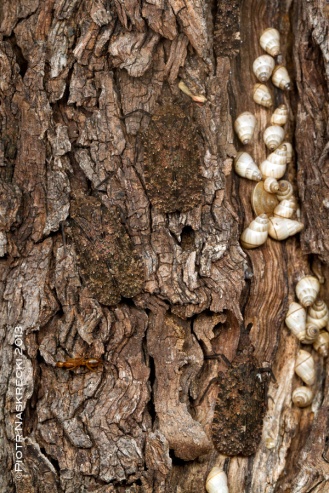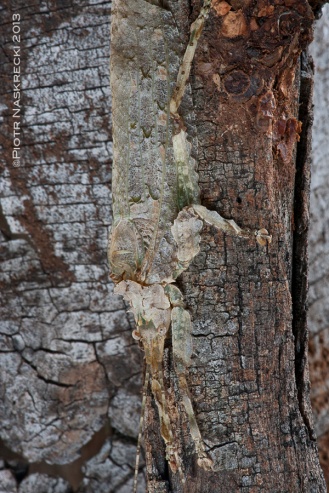
When I first read “Out of Africa”, which to this day remains one of my favorite books, the one thing that left me oddly dissatisfied was the lack of attention to trees of the savanna – their smell and colors, the texture of their bark and, most importantly, all the wonderful creatures that the author must have seen among the leaves and branches. How could Isak Dinesen devote so much attention to lions and illicit romance, and not mention amorphoscelid mantids? Sheesh, what was his problem? But perhaps I was asking too much – after all, not everybody spent their childhood picking coreid bugs and geometrid moths off tree trunks, but I wasn’t happy until I could run my hand along the smooth stem of a southern African Acacia, and gasp at the sudden discovery of a gecko hiding in plain sight.
Tree bark may not appear to be a particularly exciting habitat to live in. It is essentially two dimensional, devoid of bright colors, flat. Of course it seems so only from our gargantuan, human perspective. In fact bark is a rich, diverse ecosystem, replete with deep rifts and valleys, covered by amazing vegetation, and as dangerous to live in as the heart of the savanna.
The last time I visited Africa was a few months ago, on the floodplains of Mozambique’s spectacular Gorongosa National Park. It was the beginning of the dry season, and grass was already turning yellow and stiff. With every scorching day fewer and fewer insects were active in the grasslands, and so I turned my attention to the mottled surfaces of tree trunks, hoping to find some hidden treasures. And I wasn’t disappointed.

My first discovery was somewhat accidental – it turned out to be one of nature’s most wonderful callers, a maker of melodious, bird-like trills, and I ran into him thanks to my own nature’s call. With a bottle of beer in hand, I was making my way towards a latrine (I was at a small social shindig at one of the field camps), when my other hand met something soft, velvety, and clearly alive on a stem of a small tree. What in any other person would have elicited an immediate withdrawal response, the many years of pursuit of all things small and agile caused my hand to instinctively grasp the animal tighter. Holding onto the tree and still not knowing what was under my hand, I set down the beer bottle and gently pulled the animal off the bark. When I realized what I was holding I nearly failed to deliver the reason of my night walk to its intended destination (i.e., I almost peed my pants) – it was a bark katydid (Cymatomera denticollis), an elusive creature that I only had seen once a decade earlier, and had been trying to find again ever since.

A bark katydid is nothing like your typical, green, leaf-like variety. Its body is flat, covered with fine fuzz that makes them feel warm and soft, and the legs have small lobes that make the animal blend perfectly amongst lichen-covered flakes of African bark. But crypsis is not its only defense – if feeling threatened, the katydid fans its wings, revealing a brightly yellow and black abdomen, and sends a cloud of noxious, foul-smelling chemicals. And this is exactly what happened when I opened my hand to see what was in it, and I nearly dropped the precious animal.

Over the next couple of months I spent many hours scanning the surface of tree bark in Gorongosa. This simple activity allowed me to discover and collect not only a wide range of fascinating creatures, but also make several interesting discoveries about their behavior. Among others, I found that African lantern bugs (Fulgoridae) might be a part of a complex trophic interaction, similar to what I had studied in Costa Rica, and I will be looking into this system later this year. Most people come to Gorongosa for the landscapes of the Rift Valley and lions. I am going back for the cracks in the bark and tree mantids.



Absolutely great!
If the mantis is from Gorongosa it cannot be Theopompa (it is an Asian genus). It can be Theopompella but there are other “Liturgusidae” genera that might fit better for this nymph.
I hope to see a lot more mantis pictures.
If you’re looking for bark inhabitants, it might make sense to canopy fog something like a baobab, so that you can find the ones that reside higher up than you can look. Not to mention the ones that are TOO cryptic or outside the size range you normally look for.
Fascinating – and I did grow up peeking under each piece of loose bark, usually finding gorgeous Carabus auronitens wintering in their pupal chambers – but that katidid is especially impressive. The mammalian sexchange too.
Absolutely fascinating!
You do know that Dineson was a “she” not a “he”?
I started being suspicious when I saw Meryl Streep playing Karen Blixen’s character ;-)
*pats hand consolingly* Don’t worry, dear. I get your humor. Even if I’m the only one…